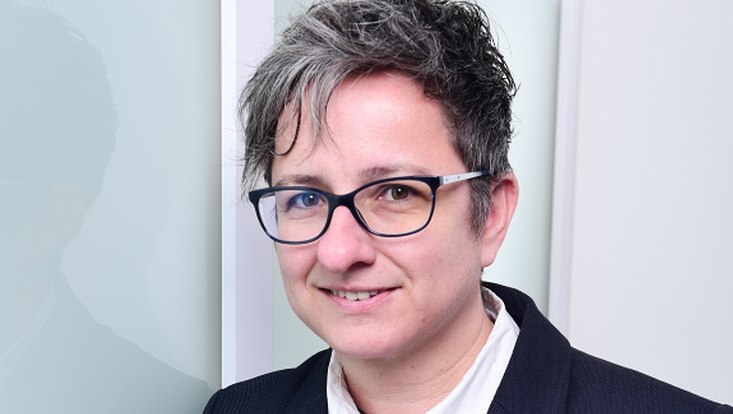“Welcome Aboard!”“Interdisciplinary questions always have to be answered within the team.”Prof. Dr. Maria Buchweitz to strengthen chemistry
10 May 2023, by Buchweitz/Latos

Photo: Private
Every year, Universität Hamburg welcomes numerous new researchers. This series introduces them and their areas of research. This time: Chemist Prof. Dr. Maria Buchweitz
Prof. Dr. Maria Buchweitz switched from the University of Stuttgart to Hamburg in April and is now a W2 professor for food chemistry in the Faculty of Mathematics, Informatics and Natural Sciences.
Dr. Buchweitz, you are now the professor of food chemistry in the Department of Chemistry. What topics will you be focusing on?
I work on the classic topics in food chemistry, meaning the qualitative and quantitative analyses of food ingredients. I am also interested in the interaction of different food ingredients during processing, ingesting, and digesting.
How can we envision that?
For example, if you bite into or cut an apple, then you destroy its cells. Substances that did not previously have contact now do and can interact. This can lead to various reactions. This is especially easy to observe, for example, when the fruit turns brown, especially in traditional types of apples.
And when, for example, we concern ourselves with the health aspects of food, we often use simplified model food and measure biomarkers in blood, urine, or tissue. Yet what actually happens in our bodies during digestion we don’t really know. Our research is an effort to unravel the mystery—one the one hand, by using clinical studies to gain greater understanding of the effects of food ingredients, and on the other to yield information about which concrete foods would be best for clinical studies to investigate the health-relevant aspects.
What health benefits are we talking about? Are we talking primarily about vitamins and minerals or also about food to treat disease?
Let’s take, for example, type 2 diabetes, a disease affecting more and more adolescents and young adults and with numerous food-related causes. When you develop this disease, there are increased spikes in sugar or “hyperglycemia” following a meal. There are already studies in which some ingredients, for example secondary plant compounds, inhibit the activity of digestive enzymes such as amylase and glucosidase in the small intestine but also react with starch when processed and thus reduce digestibility. Both lead to lower or slower glucose absorption in the blood, thus avoiding spikes in blood sugar.
This is where your research begins?
That’s right. Using various methods in the lab, we study substances that inhibit enzyme activity and are released from complex compounds when ingesting and digesting, and which concrete structural properties are responsible for the greatest possible reduction in enzyme activity. We are also looking at which processing conditions will reduce the digestibility of starches when interacting with other food substances.
Then are there certain foods that you primarily concern yourself with to study these questions?
As a rule, we look at plant foods—the apple I mentioned before is an especially good model. Here, we looked at the concrete interaction between secondary plant compounds and the allergen Mal d I. This is the allergen that takes the blame for people who allegedly have a stronger allergic reaction to commercial apples than to traditional apples.
We looked at this and discovered that traditional apples at first seem to have lower allergen content and that the storage times and conditions strongly impact the number of allergens. Our findings and methods would now be suitable for clinical studies to determine in oral allergy tests what the connection is between allergen content, secondary plant compounds, and allergy potential.
Do you plan to initiate these clinical studies in cooperation?
That is exactly the point: we need to know the limits of our own research. We are the people who make inquiries at an analytical level. Interdisciplinary questions, however, always have to be answered within the team. So we are looking for partners who can conduct these clinical studies with us. This will most certainly be a project that we continue to pursue.
Are there other projects you want to initiate?
At the moment we are modernizing our lab facilities and applying for equipment grants. Among other things, we want to procure a surface plasma resonance spectrometer to analyze the interactions between various biomolecules more precisely. We have also applied for a new mass spectrometer to identify and quantify food substances. We are well-placed for further projects and cooperation focusing on interactions between food matrices and bioactive molecules.
What innovations can students expect?
First, I will be taking over my predecessor’s courses as tradition dictates. Next year, the degree program will also go through an accreditation procedure and that is a good time to think about modernization and for discussion— because the basics that our students bring with them from their schooling change constantly, just like the profession. It is important that when studies end, we continue to send good food chemists off into the world who question the status quo, check, and always go a step further on the basis of facts. And I mean in the right direction, based on the experiences they have had in their studies here.
Why should high school students study food chemistry?
The safety and health benefits of food are important issues and the topic of many current debates. Food chemists develop analytical methods to ensure food safety and to test processes and reactions.
When, for example, we create protein extracts from plants to then create, among other things, new procedures for meat substitutes, then ingredients can react. This can lead to changes in functional properties and physiological effects. So we are not just talking about food monitoring but also about guiding new trend and product development. And those will continue to be exciting fields.


